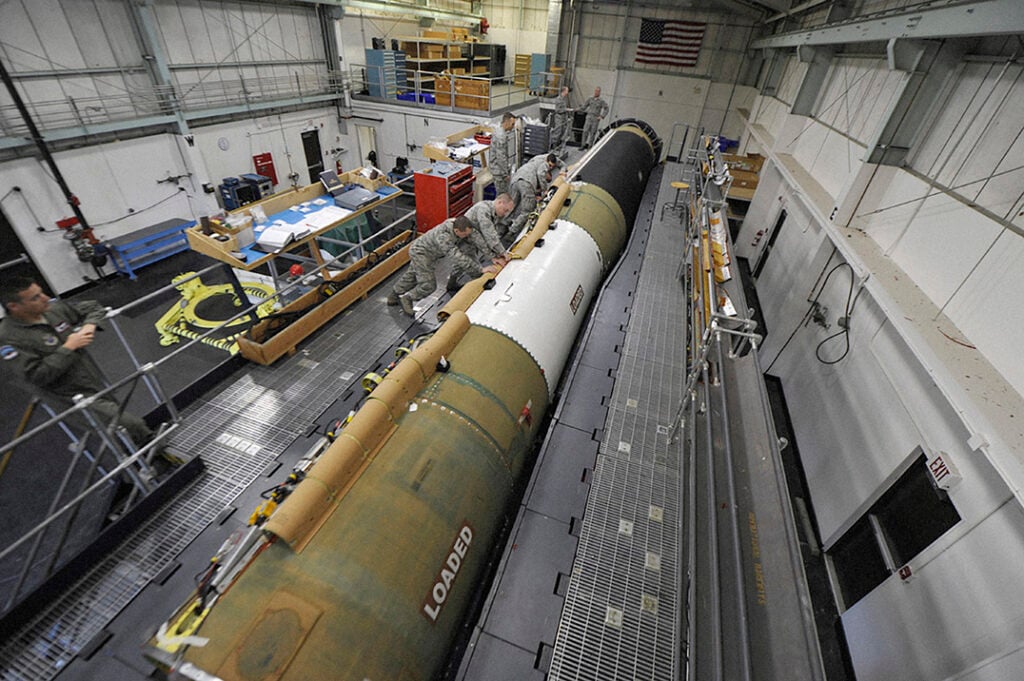
Airmen install a new cable run on an aging Minuteman III missile.
WASHINGTON: Budget. Budget. Budget. It’s the first word out of the mouths of analysts, former DoD officials and retired brass when asked (in a totally unscientific poll) to opine on the three major issues facing the Air Force in 2021. The tightly entangled questions of how much money will be available, how service leaders want to spend it, and what Congress will allow them to not spend it on simply overshadow every policy and technical issue at hand.
At the top of the list of challenges stemming from the reality of a likely cut in the Air Force’s top line is how the service will fund the the impending modernization bow wave — in particular, the sweeping update of its nuclear forces.
“The Air Force has a lot of major acquisition programs in the pipeline that are critical to its future, and it is going to have to find a way to keep these programs on track and funded despite a flat or declining budget,” says Todd Harrison, director of the Aerospace Security Project at the Center for Strategic and International Studies (CSIS). “Depending on the budget trajectory, the Air Force may also need to delay or kill some lower priority modernization programs, and it would be better to do that deliberatively through a strategically informed process than to let Congress pick and choose the winners.”
Hawk Carlisle, former head of Air Combat Command who now heads the National Defense Industrial Association, notes that even with a flat budget, once “you include inflation and the cost of personnel, you’re actually getting decreased buying power.” So, “everybody in the Air Force” is working on figuring out how to “divest to invest” in new technology along the lines articulated by new Air Force Chief of Staff Gen. CQ Brown in his Accelerate Change, Or Lose vision document.

Heather Wilson
Nukes No. 1
Former Air Force Secretary Heather Wilson says in an email that the nuclear modernization program is a key concern because the real costs are kicking in during 2021. “I think the next budget is the first one with a steep slope for the cost of refurbishing the nuclear deterrent. Replacing the Minuteman, replacing the Air Launched Cruise Missile, and the B-61, while upgrading the B-52, will take a lot of money. Historically, nuclear modernization has been handled in several different ways. But the Air Force can’t do this from inside a relatively static top line for the Air Force without crushing its ability to handle all of its other missions.”
The Congressional Budget Office put the price tag of the current DoD plan for updating/replacing its strategic delivery systems in January 2019 at a whopping $234 billion between 2019 and 2028 — $56 billion for the Air Force’s plan to replace its aging LGM-30G Minuteman III intercontinental ballistic missiles (ICBMs) that first became operational in 1970, and $38 billion for bomber upgrades. Consulting firm Cowen Washington Research Group in a September review predicted the combined cost of just the Air Force’s Ground Based Strategic Deterrent (GBSD) and the B-21 bomber is likely to triple by 2027 to some $10.2 billion each year, as production ramps up under both programs.
“It’s no secret the Biden administration will kick off the next [Nuclear Posture Review] next year. Timing and funding for nuclear triad modernization will be an issue, especially for modernizing the USAF’s ICBM force,” says Mark Gunzinger, director of future projects at the Mitchell Institute. “If I were to make a prediction, I would say that DoD will reaffirm—as all administrations have for more than 50 years—the need for a credible, effective land-based ICBM leg of the triad. Rather, the NPR will likely spend more time and effort assessing the best solution for maintaining the ICBM force.”
Harrison agrees that a key question will be: “Who gets the pen to start working on an updated Nuclear Posture Review and what that means for the GBSD program.” He added that another big question will be the schedule for the B-21 program, “in terms of when they get a test unit flying and when we start to see procurement funding in the budget request.”
Whither NGAD?
As for other modernization efforts, the Next-Generation Air Dominance (NGAD) program — and Air Force acquisition czar Will Roper’s strategy to develop and buy a sixth-generation fighter jet and drones to pair with it under his Digital Century Series acquisition strategy — comes in at Nr. 2 on the toughest problems for 2021 hit parade.
“The acknowledgement in September that the Air Force has built and test flown the Next Generation Air Dominance fighter took a lot of people by surprise – including on Capitol Hill,” Wilson notes.
“While Will Roper calls it ‘digital engineering,’ computer aided design and manufacturing wasn’t the biggest decision. It was a recognition that we need to rapidly innovate on shorter time cycles (like the Century Series F-100/101/104/105…) which means companies have to make money throughout the design, build and construction. We had to break the business model of losing money in RDT&E and making it up on a 30 year sustainment plan,” she explained.
“What the Air Force hasn’t done is get the Congress feeling comfortable with this. That is important work because this new way of doing business can be killed in the cradle. There are likely powerful companies that like the current business model,” Wilson adds. “The new aircraft approach is disruptive. Outside of the box on the financials, the manufacturing processes, the process of design. And very threatening to incumbent business model companies who have lots of shareholders, jobs in people’s districts, and armies of lobbyists.”
Teal Group’s Richard Aboulafia, long-time aviation industry analyst agreed that the critical question for NGAD is can what Roper wants to do with rolling out fighters with new capabilities every five or so years actually be done, and is that useful and/or sustainable approach. “Is the prototype strategy (and the related Digital Century Series concept) indeed the right way forward, or perhaps instead a return to a traditional new airframe development plan?”
Congress Skeptical On ABMS
Third on the list of challenges for the Air Force will be selling Congress on the Advanced Battle Management System (ABMS) program, designed to create a prototype Internet of Things for the military to underpin DoD’s emerging Joint All-Domain Command and Control (JADC2) network.
“One of the most important modernization programs in DoD is not really a program—it’s the effort to build a ubiquitous and resilient battle network that can connect all of our sensors, shooters, processing, and decision making nodes. Right now the Air Force is trying to take the lead on this for the Department by pushing ahead with JADC2 and ABMS. So far it has a tentative two-year agreement with the Army for JADC2, but no agreement with the Navy,” Harrison says. “And Congress does not appear to be completely sold on its approach to ABMS.”
‘Not completely sold’ is an understatement. Both sides of Capitol Hill, and both the authorizers and appropriators, have shown little love for ABMS in the fiscal year 2021 budget cycle. The 2021 spending bill passed by Congress and (finally) signed by outgoing President Donald Trump yesterday slashed the Air Force’s ABMS request by half: to $159 million from the requested $302 million. The congressional report (Section D of the omnibus spending package) explains the move by citing, among other defects, “poor justification materials.”
“Over the next year, the Air Force has to engage the Congress. It’s strategically important for lots of reasons,” Wilson stresses.

Hawk Carlisle
Carlisle agreed that wooing Congress is central to Air Force success in shifting its sights from legacy programs to investing in new technology across the board. “Congress has a big role in this,” he said.
Black swans?
So, since we’re prognosticating here, what do experts think might emerge as a ‘black swan,’ the dreaded unknown unknown that can throw everything into disarray?
“Well, we could have a pandemic and an economic slowdown as a result, but that’s really unlikely, right?” Wilson jokes. “Seriously, there are a number of potential crises or flash points – China/Taiwan, Russian meddling with its neighbors, Iranian escalation in the straight of Hormuz, Korean peninsula. Those aren’t really black swans, but should be concerns.”
Aboulafia also worries about violence, both at home and abroad. “Right-wing terror event in-country, from the looks of it. But more germane to the topic, it’s definitely armed hostilities in the Eastern Med, between NATO countries. Very unpleasant prospect,” he said.
Both Gunzinger and Harrison bring up the possibility of a full-scaled roles and missions review that could shake up service plans.
“Not sure if this is a black swan, but I would not be surprised if the next administration kicks off an internal review of the services’ roles and responsibilities, with an eye toward reducing excessive redundancy in force structure and capabilities,” Gunzinger said. “I think this review is a must-do if DoD is to maximize its future combat power and balance its books. It’s high time that DoD resolved long-standing issues such as which service should fund missile defenses for theater airbases, what’s the right mix of future long-range strike capabilities based on cost-per-effect analysis, etc. DoD simply cannot afford from budgetary or operational perspectives to allow the services to create and resource their particular visions for the future in a stove-piped fashion. Cross-service and cross-domain tradeoffs must be made.”
Harrison went even further, saying: “A roles and missions review decides that the ICBM force would be a better fit in the Army, since it already operates silo-based missiles (GMD) and has a fleet of helicopters and security forces to protect the launch sites and control centers.”
As for us here at Breaking D? We are putting our bets on the Killer Asteroid. (Eds. note: Theresa’s remarks do not necessarily reflect the opinions or policies of Breaking Defense, BreakingMedia or anyone else here!)






















